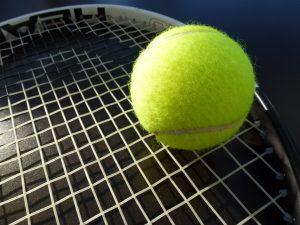We may earn money or products from the companies mentioned in this post.
A Quick Summary

Tennis is a popular sport with roots dating back to 12th century France. It is played on a rectangular court with a net dividing two halves and requires players to use rackets to hit a ball over the net into their opponent’s side. There are two main types of faults in tennis: service faults and ball faults. To reduce the occurrence of faults, players should focus on improving their technique, practicing consistently, and remaining mentally sharp during matches.
Introduction

Tennis is a sport that has captured the imagination of millions around the world With its roots dating back to 12th century France, this game has evolved over centuries to become one of the most popular individual sports globally Tennis is played on a rectangular court with a net dividing two halves and requires players to use rackets to hit a ball over the net into their opponent’s side of the court
Brief History and Popularity
Tennis originated in France in the 12th century as a game played by monks during their leisure time The modern version of tennis we know today was developed in England in the late 19th century, and it quickly spread throughout Europe and North America, becoming an Olympic sport in 1896 Tennis has since gained immense popularity worldwide, with some of the most notable tournaments being Wimbledon, French Open, US Open, and Australian Open
Basic Rules and Objectives
The objective of tennis is straightforward: hit the ball over the net into your opponent’s side so they cannot return it within bounds A point is scored when your opponent fails to return your serve or hits the ball out of bounds Players alternate serving every game, with each set consisting of six games The first player to win six games wins that set; if tied at six-all, a tie-breaker game is played until one player reaches seven points
Importance of Understanding Faults in Tennis

Understanding faults in tennis is essential for any player looking to improve their performance on the court A fault occurs when a player does not hit their serve within certain boundaries on their first attempt or violates other rules during play
Impact on Player Performance
Faults can have significant consequences for a player’s performance, as they result in a lost point and can negatively impact their confidence Consistently serving faults can also lead to frustration and cause players to lose focus, leading to further mistakes
Influence on Strategy and Tactics
Understanding faults is critical for developing effective strategies and tactics during play For example, if a player knows that their opponent has a weak second serve, they may choose to return more aggressively or position themselves closer to the service line Recognizing when an opponent is struggling with faults can also provide opportunities for players to gain an advantage
| Key Point | Description |
|---|---|
| Impact on Performance | Faults can result in lost points and negatively impact confidence |
| Influence on Strategy | Understanding faults helps develop effective strategies and tactics |
| Exploiting Weaknesses | Recognizing opponents’ struggles with faults can provide an advantage |
Types of Faults in Tennis

Service Faults
Service faults are the most common type of fault in tennis, and they occur when a player makes an error during their serve There are two types of service faults: foot faults and double faults
1 Foot Fault
A foot fault occurs when a player steps on or over the baseline while serving This type of fault is caused by poor positioning or timing, which can result in a loss of balance and stability Foot faults can be costly for players as they result in a loss of point and can even lead to disqualification from the match
a Definition and Causes
A foot fault is defined as any part of the server’s foot crossing over the baseline before hitting the ball during a serve The causes of foot faults include incorrect positioning, poor timing, or lack of concentration
b Consequences and Penalty for Foot Faulting
The consequences for committing a foot fault during play are severe The server loses that particular point, which can be frustrating for players who rely heavily on their serve to win matches Additionally, multiple instances of foot faulting can lead to penalties such as warnings, fines, or even disqualification from the game
2 Double Fault
A double fault occurs when a player fails to get their serve into play twice in succession This type of fault is particularly costly since it results in an automatic loss of point for the server
a Definition and Significance in a Match
A double fault is defined as two consecutive serves that fail to land within bounds or clear the net and go into play The significance lies in its consequence; losing one point might not seem like much but losing two points consecutively could quickly turn around momentum and flip the match
b Strategies to Avoid Double Faults
To avoid double faults, players can focus on improving their serve technique, practice consistently, and remain mentally sharp during matches It’s essential to maintain a balance between power and accuracy when serving to ensure that the ball lands in-bounds
Other Types of Faults in Tennis Play
Apart from service faults, there are other types of faults in tennis play that can also lead to point losses or penalties
1 Net Fault
A net fault occurs when a player touches the net with their body or racket during play This type of fault is caused by poor timing or lack of control over one’s movements
a Definition and Causes
A net fault is defined as any part of the player’s body or racket touching the net during play The causes include poor timing, misjudgment of distance, or lack of control over one’s movement
bConsequences for Touching the Net During Play
The consequences for touching the net during play are severe; it results in an automatic loss of point for the player who committed the fault
2 Ball Faults
Ball faults occur when a player hits a ball outside of bounds or fails to hit it within bounds while returning it back into play
aDefinition and Instances When Occurs(ball hitting body,racket etc)
Ball faults are defined as instances where players hit balls out-of-bounds or fail to hit them within bounds while returning them into play due to various reasons such as mishitting, hitting their own bodies/racket/clothing before landing on opponents’ side etc.
bEffects on Scoring and Gameplay
The effects on scoring and gameplay are significant since ball faults result in an automatic loss of point for the player who committed it Multiple instances of ball faults can lead to a warning or even disqualification in some cases
In conclusion, tennis is a game of precision and accuracy Faults are bound to happen during play, but players can minimize their occurrences by focusing on improving their technique, practicing consistently, and remaining mentally sharp during matches Understanding the different types of faults in tennis can help players avoid them and stay competitive on the court
| Key Point | Description |
|---|---|
| Precision and Accuracy | Tennis requires players to be precise and accurate in their shots to minimize faults. |
| Technique Improvement | Players should focus on improving their technique to reduce the occurrence of faults. |
| Consistent Practice | Practicing consistently helps players enhance their skills and remain mentally sharp, reducing faults during matches. |
Useful Links

What Is A Fault In Tennis? Definition & Meaning On …
What is a fault in tennis? – Rules and Definition | 2023 –
What is a Foot Fault in Tennis?
Serve (tennis) – Wikipedia
What Is a Tennis Fault? Learn the Rules and Causes
Double Fault In Tennis: Meaning, Causes & Examples
What Is A Fault In Tennis And What Is A Let Ball In Tennis
What is a Double Fault in Tennis? Unraveling the Mistake
An Overview of Faults in Tennis
Service fault. Meaning in tennis. Definition. Wiki. Terms
The Double Fault in Tennis: Causes, Consequences, and …
What Is Foot Fault In Tennis
What Is Double Fault In Tennis?
BBC SPORT | Tennis | Rules and Equipment | Serve basics …
Double fault definition in American English
Double fault Definition & Meaning
What Is A Fault In Tennis?
‘Fault One’ Tennis Cabana Shirt (100% Terrycloth)






